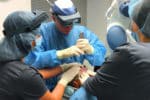Dr. Bernstein closed the 2017 ARTAS Users Meeting with a discussion of five advanced techniques in robotic hair transplant procedures that he developed at Bernstein Medical. His presentation covered the benefits of pre-making recipient sites, long-hair FUE, tensioner placement, feathering edges in harvesting, and robotic graft selection. The “Hair Restoration Pearls” presentation included case studies, photographs, and videos demonstrating the techniques to the audience of hair restoration physicians. The two-day affair; which was held in Coronado, California; was a huge success, with over 260 attendees from around the world representing 204 robotic hair restoration practices.
Pre-Making Recipient Sites
There are several advantages of pre-making recipient sites in Robotic FUE procedures. One of the most important is that grafts are out of the body for a shorter period, which increases graft survival. During placement, there is less bleeding and greater graft stickiness, which result in increased visibility for the physician, less graft popping, and up to a 30% decrease in placing time. By pre-making sites, the physician can determine the exact number of grafts needed in the hair transplant. Also, the healing process can begin in the recipient area in advance of placing. This creates a fertile bed of oxygenated tissue with factors that promote healing and the subsequent growth of the follicular unit grafts.
Long-Hair Robotic FUE
In Long-Hair Robotic FUE, the patient has their hair temporarily lifted with tape during the hair transplant surgery. The physician then harvests from the donor area in a linear configuration so that, after the procedure, the long hair is let down covering the harvested area. The long-hair technique can be applied using one harvesting row (which yields up to 1,600 grafts), a double-row (2,000 grafts), or two separate rows (2,400). Long-Hair Robotic FUE, using the ARTAS Robotic Hair Transplant System, allows the donor area to be camouflaged immediately after surgery and does not limit a patient’s ability return to work. It also makes robotic hair transplants more practical for women, who usually prefer not to shave their donor area.
Tensioner Placement
Dr. Bernstein discussed a new two-handed technique for applying the robotic tensioner to the patient’s scalp. The tensioner applies traction to the scalp, stabilizes the skin, limits bleeding, and provides a system of fiducials that the ARTAS robot “reads” for proper orientation. Dr. Bernstein showed a video in which he demonstrates the technique and discusses the importance of applying the silicon straps as vertically as possible to ensure the greatest tension and stability. The two-hand technique allows for reduced stress on the physician’s hands, better control, and more accurate placement of the tensioner. It also facilitates easier edge engagement to create tension on the skin in preparation for harvesting.
Feathering Edges
Feathering is a common technique to avoiding a squared-off, geometric look after the FUE procedure. It allows the patient to maintain a natural look while wearing their hair short after the procedure. Dr. Bernstein presented two different ways to feather using existing capabilities of the ARTAS system. Dr. Bernstein showed how the physician can both round the edges of the harvest area and decrease the density on the outer edges, with simple, reproducible techniques. Most importantly, he discussed the situations in which feathering is important and the ones in which it should not be used.
Robotic Follicular Unit Graft Selection
Robotic graft selection is an advance over the harvesting technique used in earlier iterations of the ARTAS robot. The robot previously harvested grafts at random. By creating a software algorithm designed to skip over one-hair units and select only the larger follicular units, the harvesting process improved in efficiency. According to Dr. Bernstein’s study, the clinical benefit is 11.4% more hairs per graft and 17% more hairs per harvest attempt using this technique. Larger follicular unit grafts can be dissected into one-hair units for use in the frontal hairline and other cosmetically important areas in order to create the most natural aesthetic outcome in the hair transplant while minimizing the number of recipient wounds.
Posted by 


 Video: Tensioner Placement
Video: Tensioner Placement


